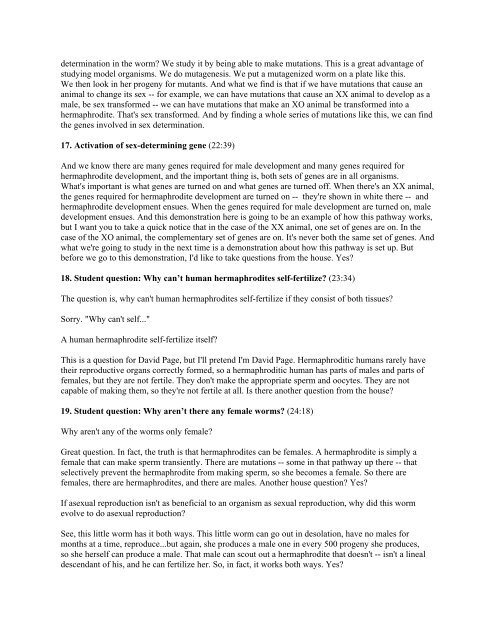The Meaning Of Sex: Genes And Gender Lecture - Howard Hughes ...
The Meaning Of Sex: Genes And Gender Lecture - Howard Hughes ...
The Meaning Of Sex: Genes And Gender Lecture - Howard Hughes ...
You also want an ePaper? Increase the reach of your titles
YUMPU automatically turns print PDFs into web optimized ePapers that Google loves.
determination in the worm? We study it by being able to make mutations. This is a great advantage of<br />
studying model organisms. We do mutagenesis. We put a mutagenized worm on a plate like this.<br />
We then look in her progeny for mutants. <strong>And</strong> what we find is that if we have mutations that cause an<br />
animal to change its sex -- for example, we can have mutations that cause an XX animal to develop as a<br />
male, be sex transformed -- we can have mutations that make an XO animal be transformed into a<br />
hermaphrodite. That's sex transformed. <strong>And</strong> by finding a whole series of mutations like this, we can find<br />
the genes involved in sex determination.<br />
17. Activation of sex-determining gene (22:39)<br />
<strong>And</strong> we know there are many genes required for male development and many genes required for<br />
hermaphrodite development, and the important thing is, both sets of genes are in all organisms.<br />
What's important is what genes are turned on and what genes are turned off. When there's an XX animal,<br />
the genes required for hermaphrodite development are turned on -- they're shown in white there -- and<br />
hermaphrodite development ensues. When the genes required for male development are turned on, male<br />
development ensues. <strong>And</strong> this demonstration here is going to be an example of how this pathway works,<br />
but I want you to take a quick notice that in the case of the XX animal, one set of genes are on. In the<br />
case of the XO animal, the complementary set of genes are on. It's never both the same set of genes. <strong>And</strong><br />
what we're going to study in the next time is a demonstration about how this pathway is set up. But<br />
before we go to this demonstration, I'd like to take questions from the house. Yes?<br />
18. Student question: Why can’t human hermaphrodites self-fertilize? (23:34)<br />
<strong>The</strong> question is, why can't human hermaphrodites self-fertilize if they consist of both tissues?<br />
Sorry. "Why can't self..."<br />
A human hermaphrodite self-fertilize itself?<br />
This is a question for David Page, but I'll pretend I'm David Page. Hermaphroditic humans rarely have<br />
their reproductive organs correctly formed, so a hermaphroditic human has parts of males and parts of<br />
females, but they are not fertile. <strong>The</strong>y don't make the appropriate sperm and oocytes. <strong>The</strong>y are not<br />
capable of making them, so they're not fertile at all. Is there another question from the house?<br />
19. Student question: Why aren’t there any female worms? (24:18)<br />
Why aren't any of the worms only female?<br />
Great question. In fact, the truth is that hermaphrodites can be females. A hermaphrodite is simply a<br />
female that can make sperm transiently. <strong>The</strong>re are mutations -- some in that pathway up there -- that<br />
selectively prevent the hermaphrodite from making sperm, so she becomes a female. So there are<br />
females, there are hermaphrodites, and there are males. Another house question? Yes?<br />
If asexual reproduction isn't as beneficial to an organism as sexual reproduction, why did this worm<br />
evolve to do asexual reproduction?<br />
See, this little worm has it both ways. This little worm can go out in desolation, have no males for<br />
months at a time, reproduce...but again, she produces a male one in every 500 progeny she produces,<br />
so she herself can produce a male. That male can scout out a hermaphrodite that doesn't -- isn't a lineal<br />
descendant of his, and he can fertilize her. So, in fact, it works both ways. Yes?

















